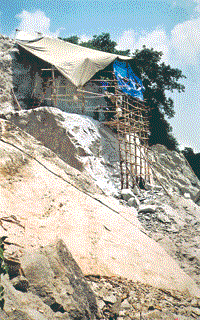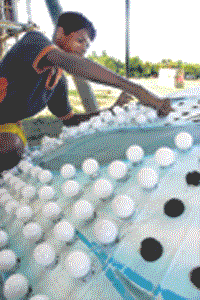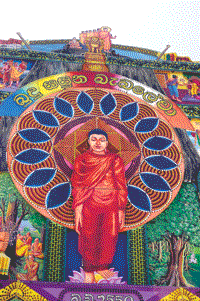| Plus |
|
||||||||||||
|
Buddhism’s first Bhikkuni The greatest Buddhist woman, heroic figure The only sister of mother Queen Maha Maya Seven days after birth of Prince Siddhartha The new Queen’s magnanimous gesture, maternal
sacrifice. Maha Pajapathi Gothami a few years later King Suddhodhana’s death changed Gothami’s
lay life Touching upon sense of gratitude, delicate matter
smoothly Buddha’s devoted close associate Ven. Ananda
ardently Kapilavasthu to Vesali her gruelling march for
Liberation All women should extremely be grateful, her endeavour
- Kumari Kumarasinghe Tennakoon
A huge act of faith By Chandani Kirinde
Surrounded by lush greenery, on a granite rock, the largest Samadhi Buddha statue of Lord Buddha is fast taking shape at the Vidyasagara Pirivena Vihara, Moneragala - in the village of Rambodagalla in the Kurunegala district. It is apparently the largest such undertaking since the end of the Polonnaruwa era. It was the senseless destruction of the two colossal Buddha statues at Bamiyan in Afghanistan in 2001 that inspired the Chief Incumbent of the Vihara, Ven. Egodamulle Amaramoli Thera to undertake such a mammoth task. Initially a committee was appointed to study the feasibility of the idea. With the Thera receiving the support of all the “dayakayas” of his temple as well as other associates, it was decided that, instead of lamenting the destruction of the Buddha statues in Bamiyan, this irrational act of destruction would be used to reinforce the determination among Buddhists to overcome and defy such impediments.
Initially Amaramoli Thera approached several local sculptors to ascertain their views on carving a statue out of a rock but as they were reluctant to undertake the project, through one of his close confidants D. Ishwaran, the Thera met with a leading South Indian sculptor Padmasri Shipla Kalamani M.Muthiah Sthapathi. After a preliminary discussion in Chennai, the master sculptor came to the Rambodagalla temple in March 2002 and having examined the 70 foot high rock within the Vihara premises agreed to under- take the project. He decided the height of the statue would be 67.5 feet. Although this is the first statue of the Buddha that Mr. Sthapathi has undertaken to sculpt, his other accomplishments include carving a 60-foot tall statue of Lord Krishna in Calcutta on granite as well as several other sculptures in leading temples in India. Work began in late 2002 with eight Indian sculptors working under the supervision of Mr. Sthapathi. With the total estimated cost of the project at around Rs. 12 million including payment for workers and equipment needed, it seemed a Herculean task. Much of the work on the facial features of the Buddha is now complete and the statue is expected to be completed by April next year. The once solid rock is now clearly beginning to show the outline of the figure with the sculptors working with great dedication in the sweltering sun to complete this undertaking of faith. Indian High Commissioner Nirupama Rao has been among the distinguished visitors to the site where the statue of the seated Buddha is taking shape. The High Commissioner who visited the temple in February this year also made a generous donation of Indian rupees one million (nearly Rs 2.4 million) towards this project. “I am deeply privileged to be present here at the site of what is to be the world’s largest granite statue of Lord Buddha whose eternal message of peace, love and compassion to all living beings provides a powerful beacon in our daily lives,” wrote High Commissioner Rao in the visitors’ book at the Vihara. This statue, once completed, will once more remind people of the Buddha’s message in the same manner that all such statues such as those at “Aukana” and Gal Vihare in Polonnaruwa have been doing for hundreds of years.
They light up the Vesak nights By Ayesha Inoon On the night of Vesak and for several nights after, the glow of the moon is eclipsed by the brilliance of the many Vesak pandals around the city. These huge structures that are a unique Sri Lankan aspect of Vesak celebrations, are works of art that combine the many skills of artists, painters, electricians and minor workers to achieve the final masterpiece.
The pandals combine panels of pictures that tell
a story from either the life of Lord Buddha, His previous births
(also known as the Pansiya Panas Jathakaya), or from the history
of Buddhism. In the centre, there is always a statue of Lord Buddha.
Thousands of tiny coloured bulbs illuminate the pictures, often
blending in with the pictures themselves.
The pandal at the Parliament grounds tells the story of ‘Dasa Raja Dharmaya’ and is a creation of veteran artist Jayasiri Semage. Originally to have been constructed near President’s House, it was moved there at the last minute due to security reasons. “Now we are working night and day to finish this on time,” says a worker at the site. At a height of 62 feet and with over 40,000 bulbs to be put in place, it is no easy task. Work on the pandal at the Borella junction was started in early January, says an electrician as he supervises the final touches of his crew. The paintings were done by Pushpananda Denipitiya and the script was written by Mervin Senaratne. The pandal will be on view for about a week, he says, after which it is taken down and the picture panels put away, unless they are requested elsewhere. Pandals were part of the revival of Buddhism that occurred during the last stages of British rule in Sri Lanka, says Professor J.B. Disanayaka, when Vesak and the day preceding it were declared public holidays. The idea behind it may have come from Indian sculptures which were used to depict stories, he says. Along with the kudus, the pandals, with their
bright lights, pictures and story-telling, add colour to the Vesak
celebrations, and to see one in all its glory at night and take
in its special message is an experience not to be missed. |
|||||||||||||
Copyright © 2006 Wijeya Newspapers
Ltd. All rights reserved. |



